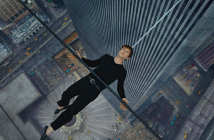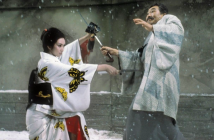
Editor’s Notes: The Revenant is currently out in wide theatrical release.
Less than a year from winning Academy Awards for Best Director and Best Picture for Birdman, Alejandro González Iñárritu is back with another ambitious, flawed, but no less compelling exploration of masculinity and its discontents. Turning away from the 21st century preoccupations (e.g., fame, celebrity, identity, authenticity, etc.) that, for better or for worse, defined Birdman, but collaborating once again with two-time Academy Award winner Emmanuel “Chivo” Lubezki (Gravity, The Tree of Life, Children of Men, The New World), his Birdman cinematographer, Iñárritu’s latest film, The Revenant, a loose adaptation of Michael Punke’s 2002 novel, takes as its subject the difficult-to-believe survival of Hugh Glass (Leonardo DiCaprio), an 1820s fur trapper, frontiersman, and guide from a near-death encounter with a grizzly bear and his subsequent attempt to survive and return to the equivalent of civilization and exact his revenge on the men who willingly left him behind for dead (out of desperation and self-preservation).
Less than a year from winning Academy Awards for Best Director and Best Picture for Birdman, Alejandro González Iñárritu is back with another ambitious, flawed, but no less compelling exploration of masculinity and its discontents.
At its core, there’s little about The Revenant that can be described as complex, layered, or even profound. It’s the simplest of survival stories, succeeding or failing not on narrative originality or dramatic invention, but purely on execution. Iñárritu’s ambitions, however, dictate that heavy subtext and even heavier themes, including, but not limited to, America’s relentless, relentlessly brutal Western expansionism, capitalism, and imperialism that swept away Native Americans through war, genocide, and starvation, will find themselves in the mix. Iñárritu not only introduces a Native-American wife (Grace Dove Syme) and son, Hawk (Forrest Goodluck), a fictionalized element missing from Punke’s novel, but makes the loss of both (his wife via hallucinogenic flashbacks, his son as a young adult), the guiding motivation for Glass’ seemingly endless trek through the wilderness to find John Fitzgerald (Tom Hardy), the half-deranged, mercenary trapper, who murders Hawk while an injured, near-death Glass helplessly looks on.

After a thrilling, gory, spectacular escape from a Native American tribe, the Rhee, Glass, his son, Fitzgerald, the expedition’s leader, Andrew Henry (Domhnall Gleeson), and the remaining survivors find themselves on foot, forced to abandon their boat and the fur pelts they’ve spent weeks, if not months, harvesting from the local animal population. That conflict over resources provides The Revenant with another, relatively under-developed theme. Before long, the survivors are long past arguing about profits and shares and simply hoping to survive. When Glass finds himself between a mother bear and her cubs, he’s immediately aware of the personal danger, but he doesn’t respond fast enough. The bear mauls him repeatedly over the course of several minutes (it feels significantly longer). Iñárritu doesn’t shy away from showing the brutality of the attack, the deep gouges of flesh torn and torn away, the blood pooling where flesh once existed.
At its core, there’s little about The Revenant that can be described as complex, layered, or even profound.
Glass outlasts the bear, but the magnitude and severity of his injuries suggest he won’t live long. Incapable of transporting Glass back to the closest fort, Henry does what any leader of an 1820s expedition might do: He leaves Glass behind, with Hawk, Fitzgerald, and a young, inexperienced trapper, Jim Bridger (Will Poulter), to watch over Glass until he dies and give him a proper Christian burial. When Glass doesn’t die right away, Fitzgerald tries to hasten the inevitable, but fails, leaving Hawk dead (for interfering), and Bridger somehow none the wiser. As Fitzgerald and Bridger make the difficult, exhausting return to the rudiments of civilization, Glass literally crawls out of his grave. Due to a seriously injured leg, he continues crawling across the snow-hardened ground, first to mourn the son he swore to protect but couldn’t and later inch by painful inch in sub-zero weather conditions, driven by two, primal instincts: self-preservation and revenge.
The Rhee who attacked the trappers are never far behind, giving Iñárritu and Lubezki the opportunity to stage several additional set pieces, one involving a freezing, raging river (and a waterfall), and later, after a near-rescue by an empathetic Native American goes predictably awry (blame goes to casually, overtly racist French fur traders), another near miss over a cliff and into the literal belly of a newly dead horse (shades, intentionally or not, of Star Wars: The Empire Strikes Back). It’s difficult, if not impossible, to argue against the skill, talent, and craft behind those set pieces, especially given the severe weather conditions that led to several reports of mistreated crew members and crew defections. Iñárritu firmly believes that suffering for art – if indeed, The Revenant qualifies as art in a broad or narrow sense – is an absolute necessity. With the help of Lubezki’s ravishing cinematography (using natural light and mostly limited to “magic hour”/twilight shooting) and a stellar cast led by a committed DiCaprio (working hard as ever for his first Academy Award win), The Revenant succeeds visually without qualification or reservation, but it’s also in service to a relatively thin, simplistic survival narrative and over-obvious, depth-free themes.
The Revenant succeeds visually without qualification or reservation, but it’s also in service to a relatively thin, simplistic survival narrative and over-obvious, depth-free themes.



